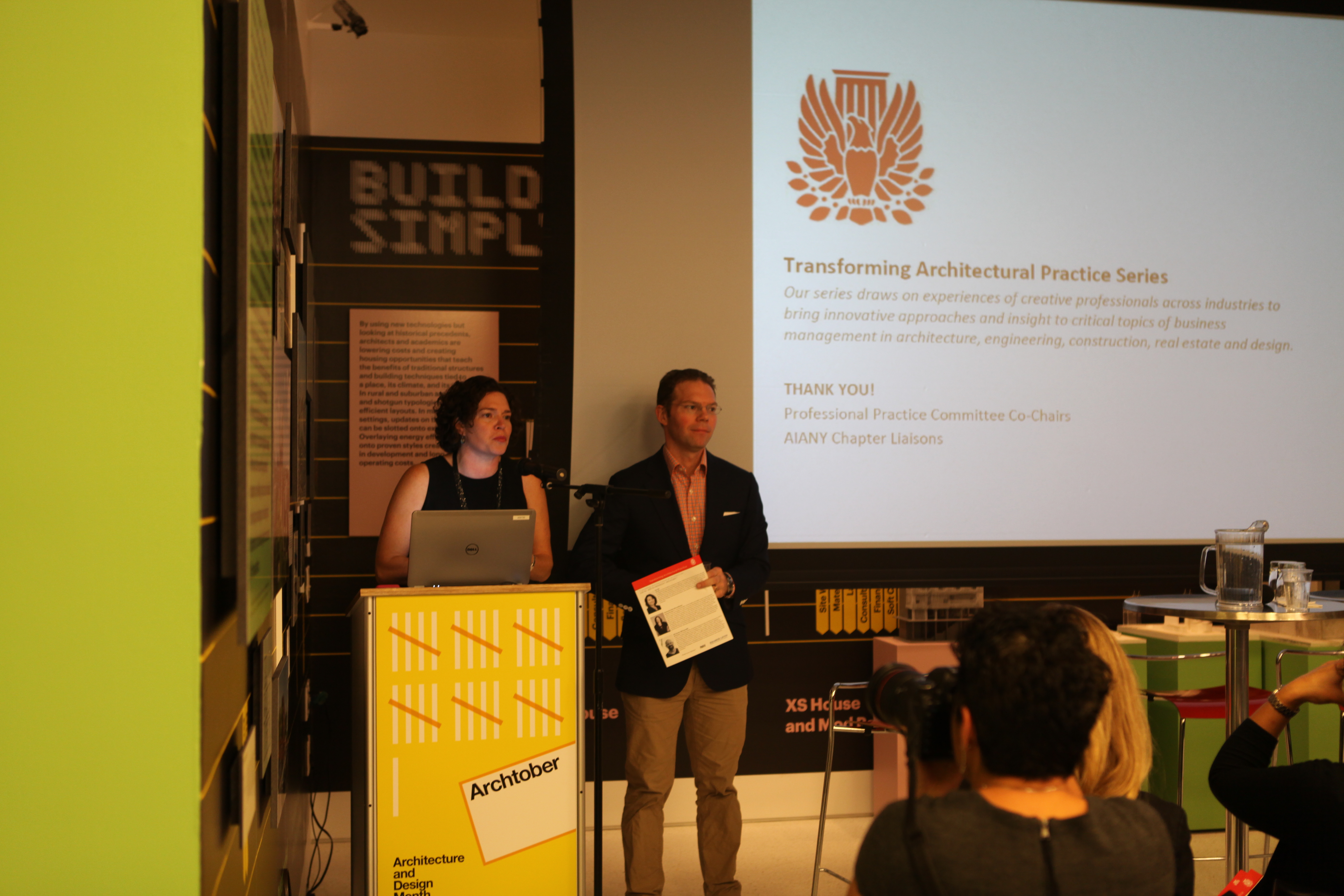by: Claire Rowell
On 10.07.15, the AIANY Professional Practice Committee’s Transforming Architectural Practice series brought together five thought leaders whose converging perspectives define what is at the crux of coworking: a successful coworking environment must consider many occupant, business, and spatial drivers. Speakers represented different coworking scales. Researcher and Strategist Melissa Marsh, articulated the occupant and business drivers of coworking. Pay Wu, a real estate leader at American Express, considered the applications of coworking in corporate environments. Rosemarie Ryan, who is developing the future of coworking through Co:collective and Grind. Bill Dowzer, a leader at Australia’s BVN Architects, has designed spaces informed by human, environmental, and socio-cultural factors. Moderator Greg Lindsay, a fellow of the New Cities Foundation, investigated new modalities of interaction and connection in the urban context and beyond.
Opening remarks by Lindsay questioned how workplace design shapes and is shaped by society. If the workplace is a physical manifestation of how corporate culture “happens,” then what does the seismic shift towards coworking say about the relationship between organizations, people, and space?
Marsh leads a workplace research team of sociologists, anthropologist, and data evangelists who have conducted studies at coworking sites to understand occupant behavior, human interaction, and business relationships. Expanding on Lindsay’s question, Marsh remarked, “Coworking growth over the past decade represents a phenomenal opportunity to really understand and redefine the valuation of space. By defining and articulating the drivers of choice, coworking is a unique stage [on which] to quantify and demonstrate the value of space and the total experience of its many attributes.” She describes this as the ”consumerization of workspace,” where people now have agency in defining their own work environment. Through research and consulting, Marsh’s team proves that coworking provides a new array of occupant sentiment data, which architects and their clients can leverage to define, design, and operate workspaces amidst changing business and workforce demands.
Wu began with a recollection of her college courses that emphasized the importance of human factors in workplace design: social cohesion, trust, support, comfort. These are among the principles that have supported her in successfully integrating a range of coworking features into American Express’s corporate environments. Having shepherded this initiative, coined AmEx Bluework, Wu knows that the success of a workplace is attributed only partially to design; many of the drivers of workplace occupancy and satisfaction are also attributed to management, organizational alignment, socialization, and leadership investment.
Harking back to Lindsay’s opening statement about the mutual impact of space and society, Ryan quoted Winston Churchill: “We shape our buildings and afterwards, our buildings shape us.” She learned early on that workplace design directly affects business success and individual creativity. When she took on an executive role at JWT, she experienced the trials and tribulations of a work environment in crisis. “I walked into an organization that needed a different way to work together,” she said. “The only way to rebuild the organization was to redesign the workplace.” Her first move was screwdriver-to-door-frame, removing the barriers to her office with a little help from facilities management. Ryan spearheaded a highly successful workplace redesign in collaboration with Clive Wilkinson Architects and a team of workplace strategists, including co-panelist Marsh. Ryan has gone on to lend her branding genius and workplace evangelism to the founding of Grind, a network of NYC coworking spaces.
Dowzer is particularly familiar with both the phenomena of coworking, and that of creating corporate environments that borrow from the same human, environmental, and social factors that make coworking successful. He emphasized: “People have an inner sense of wanting to belong to a community. This is a direct effect of our evolutionary history, from hunter gatherers to an agrarian society, where we were creating ‘place’ together.” Dowzer has helped develop a new workplace typology – a hybrid of corporate and coworking environments where companies invite their clients and collaborators to work side-by-side. “We see companies across industries recognizing the opportunity for a whole new set of social and business interactions by trying out new models of space use that shift corporate boundaries and revalue real estate assets.” He urges designers to think beyond the trends of coworking to really explore what makes the designs relevant and successful.
Many of the successful features of coworking borrow from the diverse environments of cities and nature. How can these features, known to positively affect human cognition and social behavior, be incorporated into buildings and work environments? BVN looks to the urban context to inform design: narrow stairwells force intimate interactions, café design accelerates serendipity, a hollow core provides interior vistas and connectivity.
If coworking is not just a design trend, but a real estate, economic, and industry shift in society, what does this mean for architects who are uniquely positioned to shape our environment? Marsh defined our current moment as an opportunity to reconsider the practice and boundaries of architecture: “With the recent valuation of WeWork at $10 billion, we must think more deeply about what architecture is and who are its practitioners.” Successful coworking operators like Grind and WeWork have proved the business value of good design. Marsh prompted the audience to reconsider the profession: to reposition the value of research-driven design; to learn from the success of coworking, and to incorporate these findings into the definition, the business, and the practice of architecture.
Claire Rowell is a Workplace Anthropologist at PLASTARC, a social research, workplace innovation, and real estate strategy firm serving tenants and owner-occupiers, and collaborating with architecture and design firms.
Event: Coworking and the Future of Architecture
Location: Center for Architecture, 10.07.15
Speakers: Rosemarie Ryan, Founder, co:collective; Bill Dowzer, Principal, BVN Architects; Pay Wu, Vice President, Global Business Division, American Express; Melissa Marsh, Assoc. AIA, Founder and CEO, PLASTARC; Greg Lindsay, Fellow, New Cities Foundation (moderator)
Organized by: AIANY Professional Practice Committee









